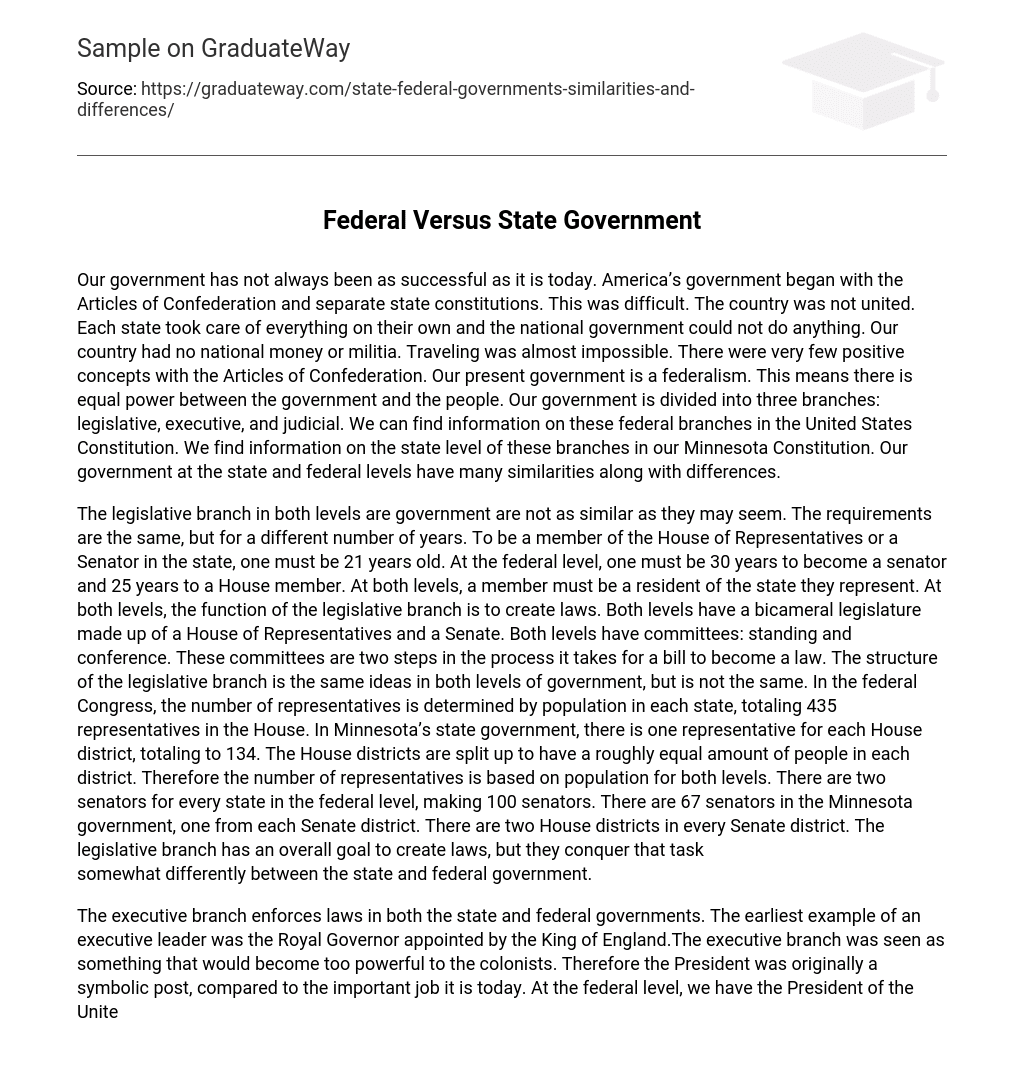The government of the United States has not always been successful. It started with the Articles of Confederation and separate state constitutions, causing difficulties and a lack of unity. Each state had its own responsibilities, preventing the national government from taking action. As a result, there was no national currency or militia, and traveling became extremely difficult. The Articles of Confederation had few positive aspects.
Currently, our government operates under federalism where power is distributed equally between the government and the people. This includes three branches: legislative, executive, and judicial. Information about these federal branches can be found in the United States Constitution, while details about state-level branches are available in our Minnesota Constitution. Although there are similarities between state and federal governments, differences also exist.
Although the legislative branch in both levels of government may appear similar, they have their differences. The requirements for becoming a member of the House of Representatives or a Senator are the same at both levels, but for different lengths of time. To be part of the state’s House of Representatives or Senate, an individual must be 21 years old. However, at the federal level, the age requirement is 30 years for a Senator and 25 years for a House member. Furthermore, members must also be residents of the state they represent in both cases.
The main function of the legislative branch is to create laws and this remains consistent at both levels. Both levels have a bicameral legislature composed of a House of Representatives and a Senate. Additionally, both levels have two types of committees: standing and conference. These committees play a crucial role in the process turning a bill into law.
While the structure of the legislative branch carries similar concepts at both levels if government, it is not identical. The number representatives in federal Congress is determined by each state’s population resulting in total 435 representatives in house.On other hand Minnesota’s state government has one representative per each house district totaling 134 representatives.The division of House districts ensures that each district has an equal number of residents, which determines the number of representatives.
At the federal level, there are two senators representing each state, making a total of 100 senators. In Minnesota’s government, there is one senator per Senate district, with a total of 67 senators. Each Senate district consists of two House districts. Although both the state and federal legislative branches have the same goal of creating laws, they use different methods to accomplish this objective.
The executive branch is responsible for enforcing laws at both the state and federal levels of government. The Royal Governor, appointed by the King of England, was the earliest example of an executive leader. Concerns over excessive power led to the initial symbolic value of the position of President compared to its current significance. In the federal government, ultimate authority lies with the President of the United States. The Cabinet, comprised of heads from fifteen executive departments, also holds significant power. At a state level, the Governor is supported by positions like Lieutenant Governor, Secretary of State, State Auditor, and Attorney General in administering state laws and affairs. They appoint department heads and judges in case vacancies arise and serve as commander-in-chief for state military forces. Additionally,the Governor has responsibilities similar to those of a President on a national scale including approving or vetoing bills.There are additional powers specific to being President,such as convening Congress,making treaties with other countries,and granting pardons for crimes committed.However,the executive branches at both levels play essential roles in governing and upholding laws.
The judicial branch is organized similarly at both levels, but differs in jurisdiction. The court system starts with the District Court and goes up to the Court of Appeals, ending with the Supreme Court. There are 94 federal district courts and 10 Minnesota district courts. State district courts handle most cases like federal district courts, but federal courts handle national offenses such as constitutional rights violations, federal crimes, disputes within the U.S. government or between states/nations, and crimes on international waters. State courts deal with criminal and civil cases within their respective states – this is the main difference between state and federal levels. Other courts follow a similar structure.
The Court of Appeals reviews appealed cases from lower courts without determining guilt or innocence; its role is to assess if a fair trial was conducted in the District Court.The number of judges varies: three-judge panel for federal Court of Appeals whereas one chief judge and fifteen associate judges for state Court of Appeals.
Both the Federal Supreme Court and the Minnesota Supreme Court, operating at their respective levels of government, have a similar structure within their judicial branches.The highest court known as the Supreme Court presides over significant legal matters.While the federal court is composed of 9 justices, the Minnesota Supreme Court has one chief justice and six associate justicesBoth courts hear cases regarding the constitution, whether it is their initial hearing or a subsequent one.
Although there are similarities and differences between the state government and federal government, both share the same purpose in their legislative, executive, and judicial branches. However, they vary in terms of structure and organization while ultimately aiming to govern our nation. The state government can be perceived as a localized rendition of the federal government. Presently, we have a government that unifies us as one country rather than separate states, something we can take pride in despite having individual state constitutions.





